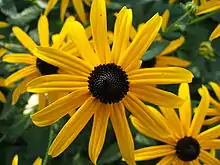Rudbeckia fulgida
Rudbeckia fulgida, the orange coneflower[1] or perennial coneflower,[2] is a species of flowering plant in the family Asteraceae, native to eastern North America.
| Rudbeckia fulgida | |
|---|---|
 | |
| Scientific classification | |
| Kingdom: | Plantae |
| Clade: | Tracheophytes |
| Clade: | Angiosperms |
| Clade: | Eudicots |
| Clade: | Asterids |
| Order: | Asterales |
| Family: | Asteraceae |
| Genus: | Rudbeckia |
| Species: | R. fulgida |
| Binomial name | |
| Rudbeckia fulgida | |
Description
It is an herbaceous perennial growing up to 120 cm (47 in) tall, with bright yellow daisy-like composite flower heads.
Growth and reproduction
Rudbeckia fulgida spreads by both stoloniferous stems and seed. The seeds are produced in fruits called cypselae, which are 2.2 to 4 mm long and have short coroniform pappi, 0.2 mm long. [3] The ripe seed is a favorite food of finches in winter.
Morphology
Stems are hairy, ridged, and dark green. Leaves are dark green, sparsely but roughly haired, simple, with sparsely serrate margins. Flowers are heads, with black disk florets and bright orange ray florets, borne singly on stems that extend above the foliage. Stems are glabrous or moderately covered in hirsute hairs with spreading branches. The leaves have blades that are lanceolate to broadly ovate or elliptic in shape without lobes. The leaf bases are attenuate to cordate in shape and the margins of the leaves are usually entire or serrate, or sometimes lacerate. The upper surfaces of the leaves are glabrous or have hirsute to strigose hairs. The basal leaves are petiolate, with petioles that are 5 to 30 cm long and 1 to 8 cm wide, the cauline or stem leaves have petioles that are 2 to 25 cm long and 0.5 to 7 cm wide, the bases are attenuate to cordate or auriculate in shape.
The flower heads are often produced one per stem but are also often produced in corymbiform arrays with 2 to 7 flowers per stem. The cups that hold the flowers called receptacles, are hemispheric to ovoid in shape with paleae 2.5 to 4 mm long, the apices are obtuse to acute in shape with the ends usually glabrous and the apical margins ciliate. The flower heads have 10 to 15 ray florets with laminae elliptic to oblanceolate in shape and 15–25 cm long and 3 to 6 mm wide. The abaxially surfaces of the laminae have strigose hairs. The flower discs or center cones are 12 to 16 mm tall and 10 to 18 mm wide, made up of 50 to over 500 disc florets, with the corollas proximally yellowish green and brown-purple distally in color, 3 to 4.2 mm long, having style branches 1.3 mm long.
Etymology
The Latin specific epithet fulgida means "shining" or "glistening".[4]
Cultivation
There are seven varieties;
- Rudbeckia fulgida var. deamii (S. F. Blake) Perdue - Deam's coneflower
- Rudbeckia fulgida var. fulgida Aiton - orange coneflower
- Rudbeckia fulgida var. palustris (Eggert ex C.L. Boynt. & Beadle) Perdue - orange coneflower, prairie coneflower
- Rudbeckia fulgida var. spathulata (Michx.) Perdue - orange coneflower
- Rudbeckia fulgida var. speciosa (Wender.) Perdue - orange coneflower
- Rudbeckia fulgida var. sullivantii (C.L. Boynt. & Beadle) Cronquist - Sullivant's coneflower
- Rudbeckia fulgida var. umbrosa (C.L. Boynt. & Beadle) Cronquist - orange coneflower
Rudbeckia fulgida var. deamii[6] and R. fulgida var. sullivantii 'Goldsturm'[7] have both gained the Royal Horticultural Society's Award of Garden Merit.[8]
Vernalization is beneficial to flower initiation. Recommendations are listed below:
References
- USDA, NRCS (n.d.). "Rudbeckia fulgida". The PLANTS Database (plants.usda.gov). Greensboro, North Carolina: National Plant Data Team. Retrieved 25 October 2015.
- BSBI List 2007 (xls). Botanical Society of Britain and Ireland. Archived from the original (xls) on 2015-06-26. Retrieved 2014-10-17.
- Rudbeckia fulgida in Flora of North America @ efloras.org
- Harrison, Lorraine (2012). RHS Latin for Gardeners. United Kingdom: Mitchell Beazley. ISBN 184533731X.
- ITIS Report: Rudbeckia fulgida Aiton
- "RHS Plant Selector - Rudbeckia fulgida var. 'deamii'". Retrieved 17 February 2021.
- "RHS Plant Selector - Rudbeckia fulgida var. sullivantii 'Goldsturm'". Retrieved 17 February 2021.
- "AGM Plants - Ornamental" (PDF). Royal Horticultural Society. July 2017. p. 93. Retrieved 11 October 2018.
- "Rudbeckia fulgida, Goldsturm, Perennial | Benary". www.benary.com. Retrieved 2016-12-27.
- "Jelitto Perennial Seed | RUDBECKIA fulgida var. sullivantii 'Goldsturm' Portion(s)". www.jelitto.com. Retrieved 2016-12-27.
- "Perennial Solutions: Rudbeckia 'Little Goldstar' – Greenhouse Product News". www.gpnmag.com. Retrieved 2016-12-27.
- "Rudbeckia fulgida var. sullivantii 'Little Goldstar' - Greenhouse Management". Greenhouse Management. Retrieved 2016-12-27.
- "Rudbeckia fulgida 'Pot Of Gold' – Greenhouse Product News". www.gpnmag.com. Retrieved 2016-12-27.